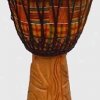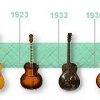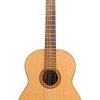Project
Good Vibrations
Have you ever wondered why that drum or that guitar makes that sound.
Well surprisingly enough they all are derived from one concept and one idea which can be easily explained through the science of music.
So sit down and and get that mouse moving as we explore the world and life of music.
  
Sound is a form of mechanical energy that travels as a wave. The wave is actually a wave of increased and decreased pressure in the medium it travels through (i.e. the particles of the medium get squashed together then spread apart). Sound can be transmitted through different media e.g. gases, liquids and solids.
The sounds we hear normally are travelling through a gaseous medium - 'air'. As a sound wave passes through air the air molecules get pushed together and then move apart again.
Have a look at this web page for a nice demonstration of this (it has GIF animations)
The number of waves in unit time is called the frequency of the wave. Sound waves with different frquencies produce different tones/pitches.
Check out this link to hear different tones.
The loudness of a sound depends on the amount of energy the sound wave has - we also call this its amplitude.
For a picture of a sound wave and explanation of pitch and loudness see this site.
To make a sound we must make the particles of a medium vibrate to generate a sound wave.
We hear sound because sound waves make the mambrane in our ear (the ear drum) vibrate which in turn creates a wave in the liquid inside our inner ears. Nerves in our inner ears react to these vibrations and our brains translate this as sound.
[more]
All musical instruments use vibration to generate sound waves. By vibrating something on the instrument (a string, a drum skin, a reed, a wooden or metal bar or block or even the players lips on the mouth piece) the air inside and /or around the instrument vibrates producing sound waves.
Many musical instruments have a hollow section and / or a cone which helps to amplify the sound. e.g. the cone at the end of a trumpet, the hollow interior of a drum, resonators in marimbas, the sound box of a guitar or violin.
In different instruments there are different ways in which to change the pitch of the sound produced. These include
- positions of finger holes
- tightness of strings
- tightness of a drum skin
- density of the metal or wooden block
For a more detailed descrition go to this web site.
[more]
Please have look at this powerpoint presentation to find out about how stringed instruments work in general. A guitar is a string instrument that was first made in Spain. It is from the 15th centuary and it was created by the Malaga people. At first they were bowl harps and fanburs which are similar to the guitar. Guitars were first made using tortoise shells, calabashes, a bents stick and silk strings. You can imagine how old it is and how it might have looked.
(video not found)watch a video of the guitar being played
[more]
As time went by the drum set evolved from the tree trunk animal skin made drum into the modern drums we see today as the Europeans conquered the African countries they took away the African drums to be used in their own society. Currently the drums have become more modern and sound different. Below you can see below how a drum set looks currently: The modern drum set consists of the standard drums with tom toms (which are the smaller drums) and cymbals (which are brass disks which give a contrasting sound).The snare drum is also another improvement to the drum as it has metal cables inside it to give it a somewhat shaker sound. All together new and different sounds evolved from the basic African animal skin drum.
[more]
African Drums
Drums were one of the first musical instruments used. The original
African Drums were first created in the 12th century by the Mandinka
people during the Mali Empire which they called it the Djembe. It was made from
a single piece of wood and carved into the shape of a goblet that is hollow
throughout with a skin covering over the top. The traditional drum is played with bare
hands. The sound made depends on the type of skin used as the covering. The
West African goat skin were thick and tougher which had a great impact on the
quality of the sound produced. The Djembe was then played at every ceremony
that the Mandinka people held that time, from wedding celebrations to baptism.
[more]
|
|

Please log in to view this section.
Last Edit 
 |
| by: |
Sarah Hanton |
| on: |
2012-03-12 22:56:41 |
|
Their Other Projects 

Please log in to view this section.
|

